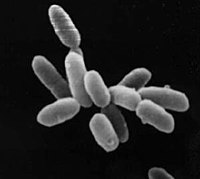
Photo from wikipedia
Reduction of the size of bacterial genomes is relevant for understanding the minimal requirements for cellular life as well as from a biotechnological point of view. Although the genome-minimized Bacillus… Click to show full abstract
Reduction of the size of bacterial genomes is relevant for understanding the minimal requirements for cellular life as well as from a biotechnological point of view. Although the genome-minimized Bacillus subtilis strain PG10 displays several beneficial traits as a microbial cell factory compared to its parental strain, a defect at the final stage of cell division was introduced during the genome reduction process. ABSTRACT Cell chaining in Bacillus subtilis is naturally observed in a subset of cells during exponential growth and during biofilm formation. However, the recently constructed large-scale genome-minimized B. subtilis strain PG10 displays a severe and permanent defect in cell separation, as it exclusively grows in the form of long filaments of nonseparated cells. In this study, we investigated the underlying mechanisms responsible for the incomplete cell division of PG10 by genomic and transcriptomic analyses. Repression of the SigD regulon, including the major autolysin gene lytF, was identified as the cause for the cell separation problem of PG10. It appeared that SigD-regulated genes are downregulated in PG10 due to the absence of the flagellar export apparatus, which normally is responsible for secretion of FlgM, the anti-sigma factor of SigD. Although mild negative effects on growth and cell morphology were observed, deletion of flgM could revert the aberrant cell-chaining phenotype and increased transformation efficiency. Interestingly, our work also demonstrates the occurrence of increased antisense transcription of slrR, a transcriptional repressor of autolysin genes, in PG10 and provides further understanding for this observation. In addition to revealing the molecular basis of the cell separation defect in PG10, our work provides novel targets for subsequent genome reduction efforts and future directions for further optimization of miniBacillus PG10. IMPORTANCE Reduction of the size of bacterial genomes is relevant for understanding the minimal requirements for cellular life as well as from a biotechnological point of view. Although the genome-minimized Bacillus subtilis strain PG10 displays several beneficial traits as a microbial cell factory compared to its parental strain, a defect at the final stage of cell division was introduced during the genome reduction process. By genetic and transcriptomic analyses, we identified the underlying reasons for the cell separation problem of PG10. In addition to enabling PG10 to grow in a way similar to that of B. subtilis wild-type strains, our work points toward subsequent targets for fine-tuning and further reduction of the genome of PG10. Moreover, solving the cell separation defect facilitates laboratory handling of PG10 by increasing the transformation efficiency, among other means. Overall, our work contributes to understanding and improving biotechnologically attractive minimal bacterial cell factories.
Journal Title: Applied and Environmental Microbiology
Year Published: 2021
Link to full text (if available)
Share on Social Media: Sign Up to like & get
recommendations!